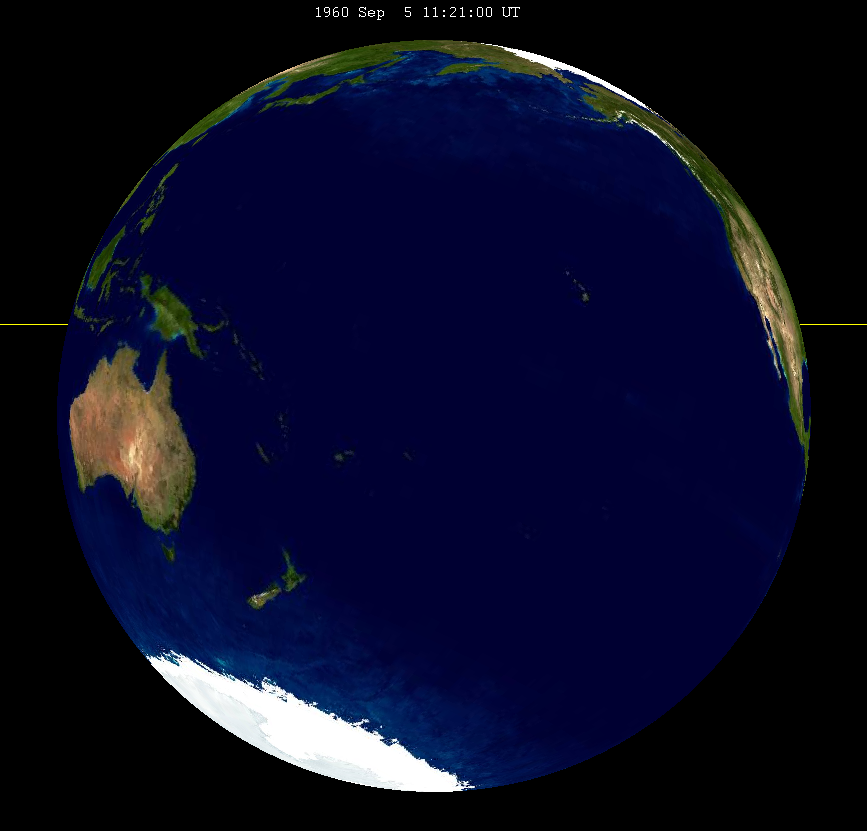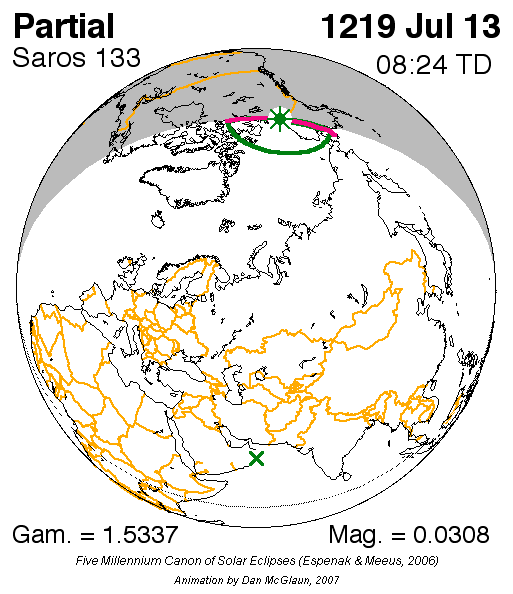|
October 1967 Lunar Eclipse
A total lunar eclipse A lunar eclipse occurs when the Moon moves into the Earth's shadow. Such alignment occurs during an eclipse season, approximately every six months, during the full moon phase, when the Moon's orbital plane is closest to the plane of the Earth ... took place on Wednesday, October 18, 1967, the second of two total lunar eclipses in 1967, the first being on April 24, 1967. Visibility It was completely visible over Asia, Australia, Pacific Ocean, North America, South America, and Arctic, seen rising over Asia and Australia and setting over North America and South America. Related lunar eclipses Lunar year series Saros series Metonic series This eclipse is the third of four Metonic cycle lunar eclipses on the same date, April 23–24, each separated by 19 years: Tritos series Half-Saros cycle A lunar eclipse will be preceded and followed by solar eclipses by 9 years and 5.5 days (a half saros).Mathematical Astronomy Morsels, Jean Meeus, p. ... [...More Info...] [...Related Items...] OR: [Wikipedia] [Google] [Baidu] |
Lunar Eclipse Chart Close-1967Oct18
Lunar most commonly means "of or relating to the Moon". Lunar may also refer to: Arts and entertainment * ''Lunar'' (series), a series of video games * "Lunar" (song), by David Guetta * "Lunar", a song by Priestess from the 2009 album '' Prior to the Fire'' * Lunars, a fictional race in the series '' The Lunar Chronicles'' by Marissa Meyer Other uses * Lunar Magic, Super Mario World level editor * Lunar Design, or LUNAR, a San Francisco-based design consultancy * Hasselblad Lunar, a digital camera * Lunar, a brandname of Ethinylestradiol/cyproterone acetate, a birth control pill * Lunar C (Jake Brook, born 1990), English rapper See also * * * Lunar calendar, based upon the monthly cycles of the Moon's phase ** Lunar day, in such calendars ** Lunar month, in such calendars * Moon (other) The Moon is Earth's only natural satellite. Moon may also refer to: Celestial bodies * Natural satellite or Moon (generic) *Moon, a Chinese asterism corresponding to 37 ... [...More Info...] [...Related Items...] OR: [Wikipedia] [Google] [Baidu] |
Solar Eclipse Of October 12, 1958
A total solar eclipse occurred on October 12, 1958. A solar eclipse occurs when the Moon passes between Earth and the Sun, thereby totally or partly obscuring the image of the Sun for a viewer on Earth. A total solar eclipse occurs when the Moon's apparent diameter is larger than the Sun's, blocking all direct sunlight, turning day into darkness. Totality occurs in a narrow path across Earth's surface, with the partial solar eclipse visible over a surrounding region thousands of kilometres wide. Totality was visible in Tokelau, Cook Islands, French Polynesia, Chile and Argentina. This solar eclipse occurred over 3 months after the final game of 1958 FIFA World Cup The 1958 FIFA World Cup was the sixth FIFA World Cup, a quadrennial football tournament for men's senior national teams, and was played in Sweden from 8 to 29 June 1958. It was the first FIFA World Cup to be played in a Nordic country. Brazil be .... Related eclipses Solar eclipses of 1957–1960 Saros ... [...More Info...] [...Related Items...] OR: [Wikipedia] [Google] [Baidu] |
List Of 20th-century Lunar Eclipses
A total of 229 lunar eclipses took place in the 20th century: 83 penumbral, 65 partial and 81 total. See also: Lists of lunar eclipses, List of 19th-century lunar eclipses and List of 21st-century lunar eclipses List Eclipses from 2001 to 2002 are included on the end to complete the final set. References This list was compiled with data calculated by Fred Espenak of NASA The National Aeronautics and Space Administration (NASA ) is an independent agency of the US federal government responsible for the civil space program, aeronautics research, and space research. NASA was established in 1958, succeedi ...'s GSFC. {{DEFAULTSORT:20th-century lunar eclipses Lunar eclipses Lunar eclipses Lunar eclipses by time ... [...More Info...] [...Related Items...] OR: [Wikipedia] [Google] [Baidu] |
List Of Lunar Eclipses
There are several lists of lunar eclipses On the Moon, by the Earth ; Type * List of central lunar eclipses * Total penumbral lunar eclipse A total penumbral lunar eclipse is a lunar eclipse that occurs when the Moon becomes completely immersed in the penumbral cone of the Earth without touching the umbra. The path for the Moon to pass within the penumbra and outside the umbra is ve ... ; Classification * List of saros series for lunar eclipses * Tetrad (astronomy) contains lists of tetrads in the late-20th and 21st centuries ; By era * Lunar eclipses by century * Historically significant lunar eclipses On Earth, by the Moon {{DEFAULTSORT:Lunar eclipses ... [...More Info...] [...Related Items...] OR: [Wikipedia] [Google] [Baidu] |
November 1974 Lunar Eclipse
A total lunar eclipse took place on Friday, November 29, 1974, the second of two lunar eclipses in 1974. The Moon was plunged into darkness for 1 hour, 15 minutes and 45 seconds, in a deep total eclipse which saw the Moon 28.961% of its diameter inside the Earth's umbral shadow. The visual effect of this depends on the state of the Earth's atmosphere, but the Moon may have been stained a deep red colour. The partial eclipse lasted for 3 hours, 28 minutes and 58.7 seconds in total. The penumbral eclipse lasted for 5 hours, 33 minutes and 11.6 seconds. The partial eclipse lasted for 3 hours, 28 minutes and 58.7 seconds. The total eclipse lasted for 1 hour, 15 minutes and 45 seconds. Occurring only 3.6 days before perigee (Perigee on Tuesday, December 3, 1974), the Moon's apparent diameter was 1.4% larger than average. Visibility It was completely visible over Europe, Africa, Asia, Australia, Pacific, western North America, seen rising over Europe and Africa and setting over the cen ... [...More Info...] [...Related Items...] OR: [Wikipedia] [Google] [Baidu] |
September 1960 Lunar Eclipse
A total lunar eclipse took place on Monday, September 5, 1960. The moon passed through the center of the Earth's shadow. This is the 39th member of Lunar Saros 127. The previous event is the August 1942 lunar eclipse. The next event is the September 1978 lunar eclipse. Visibility It was visible over the Pacific Ocean, and seen rising over Asia and Australia, and setting over North and South America. Related lunar eclipses Lunar year series Saros series Lunar saros series 127, repeating every 18 years and 11 days, has a total of 72 lunar eclipse events including 54 umbral lunar eclipses (38 partial lunar eclipses and 16 total lunar eclipses). Solar Saros 134 interleaves with this lunar saros with an event occurring every 9 years 5 days alternating between each saros series. Tritos * Preceded: Lunar eclipse of October 7, 1949 * Followed: Lunar eclipse of October 18, 1967 Tzolkinex * Preceded: Lunar eclipse of July 27, 1953 * Followed: Lunar eclipse ... [...More Info...] [...Related Items...] OR: [Wikipedia] [Google] [Baidu] |
Solar Eclipse Of October 23, 1976
A total solar eclipse occurred at the Moon's ascending node of the orbit on Saturday, October 23, 1976. A solar eclipse occurs when the Moon passes between Earth and the Sun, thereby totally or partly obscuring the image of the Sun for a viewer on Earth. A total solar eclipse occurs when the Moon's apparent diameter is larger than the Sun's, blocking all direct sunlight, turning day into darkness. Totality occurs in a narrow path across Earth's surface, with the partial solar eclipse visible over a surrounding region thousands of kilometres wide. This total solar eclipse began at sunrise in Tanzania near the border with Burundi, with the path of totality passing just north of the large Tanzanian city of Dar es Salaam Dar es Salaam (; from ar, دَار السَّلَام, Dâr es-Selâm, lit=Abode of Peace) or commonly known as Dar, is the largest city and financial hub of Tanzania. It is also the capital of Dar es Salaam Region. With a population of over s .... It then cr ... [...More Info...] [...Related Items...] OR: [Wikipedia] [Google] [Baidu] |
Solar Saros 133
Saros cycle series 133 for solar eclipses occurs at the Moon's ascending node, repeating every 18 years, 11 days, containing 72 events. All eclipses in this series occurs at the Moon's ascending node. Solar Saros 133 is one of the saros series of solar eclipse cycles. It began on July 13, 1219 with a partial eclipse occurring in northern Yukon at , about east of Canada's present-day Vuntut National Park. The final eclipse in the series will be on September 5, 2499. All eclipses in this series occurs at the Moon's ascending node. The period separating each of the 72 eclipses in the series is approximately 6585.3 days (18 years, 11 days); that period was first called a saros by astronomer Edmond Halley. This solar saros is linked to Lunar Saros 126. 20th and 21st century Five of the series of solar eclipses occur during the 21st century: November 13, 2012, November 25, 2030, December 5, 2048, December 17, 2066, and December 27, 2084. Umbral eclipses Umbral eclip ... [...More Info...] [...Related Items...] OR: [Wikipedia] [Google] [Baidu] |
Umbra
The umbra, penumbra and antumbra are three distinct parts of a shadow, created by any light source after impinging on an opaque object. Assuming no diffraction, for a collimated beam (such as a point source) of light, only the umbra is cast. These names are most often used for the shadows cast by celestial bodies, though they are sometimes used to describe levels, such as in sunspots. Umbra The umbra (Latin for "shadow") is the innermost and darkest part of a shadow, where the light source is completely blocked by the occluding body. An observer within the umbra experiences a total eclipse. The umbra of a round body occluding a round light source forms a right circular cone. When viewed from the cone's apex, the two bodies appear the same size. The distance from the Moon to the apex of its umbra is roughly equal to that between the Moon and Earth: . Since Earth's diameter is 3.7 times the Moon's, its umbra extends correspondingly farther: roughly . Penumbra T ... [...More Info...] [...Related Items...] OR: [Wikipedia] [Google] [Baidu] |





